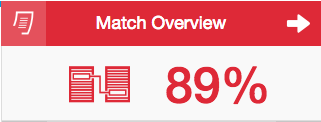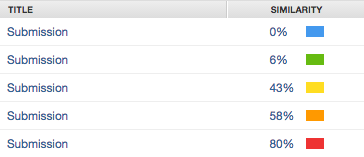Your Turnitin guidance is moving!
We’re migrating our content to a new guides site. We plan to fully launch this new site in July. We are making changes to our structure that will help with discoverability and content searching. You can preview the new site now. To help you get up to speed with the new guidance structure, please visit our orientation page .
Turnitin does not check for plagiarism in a piece of work. Instead, we will check a student's work against our database, and if there are instances where a student's writing is similar to, or matches against, one of our sources, we will flag this for you to review. Our database includes billions of web pages: both current and archived content from the internet, a repository of works students have submitted to Turnitin in the past, and a collection of documents, which comprises thousands of periodicals, journals, and publications.

It is perfectly natural for an assignment to match against some of our database. If a student has used quotes and has referenced correctly, there will be instances where we will find a match. The similarity score simply highlights any potential problem areas in a student's paper. Instructors can use this as a tool within their review process to make their own determination if any academic misconduct has occurred.
Similarity Reports provide a summary of matching or highly similar text found in a submitted paper. When a Similarity Report is available for viewing, a similarity score percentage will be made available. Similarity Reports that have not yet finished generating are represented by a grayed out icon in the Similarity column. Reports that are not available may not have generated yet, or assignment settings may be delaying the generation of the report.

Overwritten or resubmitted papers may not generate a new Similarity Report for a full 24 hours. This delay is automatic and allows resubmissions to correctly generate without matching to the previous draft.
The color of the report icon indicates the similarity score of the paper, based on the amount of matching or similar text that was uncovered. The percentage range is 0% to 100%. The possible similarity ranges are:
- Blue: No matching text
- Green: One word to 24% matching text
- Yellow: 25-49% matching text
- Orange: 50-74% matching text
- Red: 75-100% matching text
How does Turnitin detect student collusion?
Collusion is typically identified when a student's work matches with another student's submission on the same assignment or to previously submitted papers. Consider the following scenario:
Eric acquired a copy of his classmate Jane's paper. Eric submits Jane's paper as his own and receives a similarity score of 25%. Jane, who originally wrote the paper, submits her work a few days later and receives a 100% similarity score.Turnitin can identify that collusion has taken place in this scenario by running a final similarity check against all submitted assignments after the due date, thereby ensuring that every student is subject to the same level of scrutiny, regardless of when they submitted their assignments.
To enable collusion checking, papers must be set to be added to the standard paper repository or your institution’s paper repository, and Similarity Reports must be set to generate “immediately (can overwrite reports until due date)” or “on the due date."
Other scoring scenarios
Example 1:
A student may have submitted a paper to Turnitin in the past. If they had their name on that submission, it is entirely possible that, if you have not excluded small matches, their name is highlighted in their Similarity Report.
An instructor can rectify this issue by excluding by word number. In most cases, excluding 10 words should safely exclude a student's name from being highlighted in their Similarity Report.
Example 2:
A student may have used Turnitin to submit drafts of the same paper, meaning their final draft has resulted in a score of 100%.
As the instructor is likely aware that their student has submitted multiple times, they can rectify this issue by excluding the student's previous submissions from the Similarity Report.
Example 3:
A student has copied and pasted a chunk of text into their paper, due to a lack of knowledge on the topic they are covering. Their similarity score is 20%. In comparison, another student who has a firm basis of knowledge for the same assignment and knows enough to gather information from several sources to quote and reference correctly has a similarity score of 22%. Both students will be shown to have matches against our database. However, one of these students copied directly from a website, whereas the other provided properly sourced quotes.
Instructors can opt to exclude quotes from the Similarity Report to lower similarity scores where applicable.
Example 4:
A student has submitted a qualitative study to Turnitin, including a significant number of quotes and an extensive bibliography, as required for the topic of the paper. The student's similarity score is 53%; this exceeds the acceptable score set by their institution.
This issue could have been avoided if quotes and bibliography had been excluded from the Similarity Report.
Was this page helpful?
We're sorry to hear that.
